Multi-Variable Optimization of Sustainable Alkali-Activated Mortar with High Waste Concrete Powder Dosage for Enhanced Drying Shrinkage Resistance
Abstract
1. Introduction
2. Raw Materials and Methods
2.1. Material
2.2. Mix Design and Preparation
2.3. Test Methods
2.3.1. Drying Shrinkage Test
2.3.2. Microscopic Characterization Tests
3. Results and Analysis
3.1. The Influence of Mix Factors on HWAASM’s Drying Shrinkage
3.2. Model Establishment and Analysis
3.3. RSM Analysis
3.4. Microstructure
3.4.1. Changes in the Reaction Products of HWAASM
3.4.2. Thermogravimetric Analysis of HWAASM
3.4.3. Analysis of Pore Structure in HWAASM
3.4.4. Analysis of Matrix Uniformity of HWAASM
3.5. Discussion
4. Conclusions
- RSM optimization identifies a parameter window that delivers ultra-low drying shrinkage for HWAASM: WCP-R = 33.6 µm, AM = 1.23, AC = 6.03%, and W/S = 0.49. Sample R2M3A2W3, whose settings fall within this window, records 1682.2 µε, matching the model prediction and markedly below the values typical of conventional AAS.
- Larger WCP particles (33.6 μm) mainly act as fillers due to their high crystalline phase content (calcite, quartz), which suppresses shrinkage. WCP particles that are smaller in scale (15.2 μm) encourage the creation of the amorphous phase via nucleation, although this can concurrently heighten the propensity for shrinkage.
- A high AM (1.6) reduces the large pore ratio (<0.05 μm) and optimizes the pore distribution. A low W/S (0.46) reduces the total porosity to 7.67%, effectively limiting moisture migration and thereby suppressing shrinkage.
- A combination of moderate AC (6–7%) and high AM (1.6) can reduce matrix cracking, while excessive AC (8%) accelerates the reaction and generates defective pores, leading to increased shrinkage.
Author Contributions
Funding
Data Availability Statement
Conflicts of Interest
References
- Amran, M.; Murali, G.; Khalid, N.H.A.; Fediuk, R.; Ozbakkaloglu, T.; Lee, Y.H.; Haruna, S.; Lee, Y.Y. Slag uses in making an ecofriendly and sustainable concrete: A review. Constr. Build. Mater. 2021, 272, 121942. [Google Scholar] [CrossRef]
- Batuecas, E.; Ramón-Álvarez, I.; Sánchez-Delgado, S.; Torres-Carrasco, M. Carbon footprint and water use of alkali-activated and hybrid cement mortars. J. Clean. Prod. 2021, 319, 128653. [Google Scholar] [CrossRef]
- Cai, R.; Ye, H. Clinkerless ultra-high strength concrete based on alkali-activated slag at high temperatures. Cem. Concr. Res. 2021, 145, 106465. [Google Scholar] [CrossRef]
- Zhang, D.; Hao, W.; Yang, Q. Experimental Study on the Application of Recycled Concrete Waste Powder in Alkali-Activated Foamed Concrete. Materials 2023, 16, 5728. [Google Scholar] [CrossRef] [PubMed]
- Zhang, P.; Wang, K.; Li, Q.; Wang, J.; Ling, Y. Fabrication and engineering properties of concretes based on geopolymers/alkali-activated binders—A review. J. Clean. Prod. 2020, 258, 120896. [Google Scholar] [CrossRef]
- Ranjan, R.; Prusty, S.R.; Rout, B.; Panigrahi, R.; Jena, S. Assessing the effect of sodium nitrite as corrosion inhibitor against the corrosion of steel rebar in alkali-activated concrete. J. Build. Eng. 2024, 92, 109737. [Google Scholar] [CrossRef]
- Shagñay, S.; Bautista, A.; Donaire, J.; Torres-Carrasco, M.; Bastidas, D.M.; Velasco, F. Chloride-induced corrosion of steel reinforcement in mortars manufactured with alternative environmentally-friendly binders. Cem. Concr. Compos. 2022, 130, 104557. [Google Scholar] [CrossRef]
- Zhang, B.; Ma, Y.; Yang, Y.; Zheng, D.; Wang, Y.; Ji, T. Improving the high temperature resistance of alkali-activated slag paste using municipal solid waste incineration bottom ash. J. Build. Eng. 2023, 72, 106664. [Google Scholar] [CrossRef]
- Wang, D.; Zhang, Z.; Shi, C.; Wang, Y.; Ren, Q.; Ning, C.; Liu, X.; Jiang, Z. Comparison study of ultra-high performance geopolymer concrete (UHPGC) and ultra-high performance concrete (UHPC): Mechanical properties, durability and carbon emissions. Compos. B Eng. 2025, 307, 112903. [Google Scholar] [CrossRef]
- Yu, Y.; Al-Damad, I.M.A.; Foster, S.; Nezhad, A.A.; Hajimohammadi, A. Compressive strength prediction of fly ash/slag-based geopolymer concrete using EBA-optimised chemistry-informed interpretable deep learning model. Dev. Built Environ. 2025, 23, 100736. [Google Scholar] [CrossRef]
- Seo, J.; Park, S.; Kim, G.M.; Park, S. Exploring natural and accelerated carbonation of alkali-activated slag. Constr. Build. Mater. 2024, 432, 136459. [Google Scholar] [CrossRef]
- Liu, L.; Xu, Y.; Liu, H.; Xie, M.; He, Y.; Shi, C. Drying shrinkage and microstructure of alkali-activated slag with different mixing time at low temperatures (−5 to 5 °C). Constr. Build. Mater. 2022, 360, 129529. [Google Scholar] [CrossRef]
- Bakharev, T.; Sanjayan, J.G.; Cheng, Y.B. Resistance of alkali-activated slag concrete to alkali–aggregate reaction. Cem. Concr. Res. 2001, 31, 331–334. [Google Scholar] [CrossRef]
- Damrongwiriyanupap, N.; Wachum, A.; Khansamrit, K.; Detphan, S.; Hanjitsuwan, S.; Phoo-ngernkham, T.; Sukontasukkul, P.; Li, L.y.; Chindaprasirt, P. Improvement of recycled concrete aggregate using alkali-activated binder treatment. Mater. Struct. 2021, 55, 11. [Google Scholar] [CrossRef]
- Tang, Q.; Ma, Z.; Wu, H.; Wang, W. The utilization of eco-friendly recycled powder from concrete and brick waste in new concrete: A critical review. Cem. Concr. Compos. 2020, 114, 103807. [Google Scholar] [CrossRef]
- Gao, H.; Hamed, E.; Al-Damad, I.M.A.; Hajimohammadi, A.; Foster, S. Creep behaviour of alkali activated slag and fly ash concrete: Effects of hypothetical thickness, aggregates, and loading age. Mater. Struct. 2025, 58, 160. [Google Scholar] [CrossRef]
- Fang, S.; Lam, E.S.S.; Li, B.; Wu, B. Effect of alkali contents, moduli and curing time on engineering properties of alkali activated slag. Constr. Build. Mater. 2020, 249, 118799. [Google Scholar] [CrossRef]
- Zhang, P.; Kang, L.; Zheng, Y.; Zhang, T.; Zhang, B. Influence of SiO2/Na2O molar ratio on mechanical properties and durability of metakaolin-fly ash blend alkali-activated sustainable mortar incorporating manufactured sand. J. Mater. Res. Technol. 2022, 18, 3553–3563. [Google Scholar] [CrossRef]
- Aydın, S.; Baradan, B. Effect of activator type and content on properties of alkali-activated slag mortars. Compos. B Eng. 2014, 57, 166–172. [Google Scholar] [CrossRef]
- Liu, C.; Wu, H.; Li, Z.; Shi, H.; Ye, G. Effect of curing condition on mechanical properties and durability of alkali-activated slag mortar. Constr. Build. Mater. 2024, 439, 137376. [Google Scholar] [CrossRef]
- Nanayakkara, O.; Gunasekara, C.; Sandanayake, M.; Law, D.W.; Nguyen, K.; Xia, J.; Setunge, S. Alkali activated slag concrete incorporating recycled aggregate concrete: Long term performance and sustainability aspect. Constr. Build. Mater. 2021, 271, 121512. [Google Scholar] [CrossRef]
- AS 3600:2018; Concrete Structures. Standards Australia: Sydney, NSW, Australia, 2018.
- Tan, W.; Xi, B. Toward Carbon Emission Reduction in Steel Production by Substituting Pulverized Coal and Coke with Biochar. ACS EST Eng. 2024, 4, 1253–1255. [Google Scholar] [CrossRef]
- Tejas, S.; Pasla, D. Approach to design sustainable alkali-activated slag recycled aggregate concrete: Mechanical and microstructural characterization. Case Stud. Constr. Mater. 2024, 21, e03886. [Google Scholar] [CrossRef]
- Sun, C.; Chen, L.; Xiao, J.; Singh, A.; Zeng, J. Compound utilization of construction and industrial waste as cementitious recycled powder in mortar. Resour. Conserv. Recycl. 2021, 170, 105561. [Google Scholar] [CrossRef]
- Wang, X.; Yan, Y.; Tong, X.; Gong, Y. Investigation of Mineral Admixtures on Mechanical Properties of Alkali-Activated Waste concrete powders Cement. Buildings 2022, 12, 1234. [Google Scholar]
- Horsakulthai, V. Effect of Waste concrete powder on strength, electrical resistivity, and water absorption of self-compacting mortars. Case Stud. Constr. Mater. 2021, 15, e00725. [Google Scholar]
- Ren, P.; Li, B.; Yu, J.-G.; Ling, T.-C. Utilization of recycled concrete fines and powders to produce alkali-activated slag concrete blocks. J. Clean. Prod. 2020, 267, 122115. [Google Scholar] [CrossRef]
- Zhu, H.; Shen, Z.; Li, Z.; Zhao, Z.; Shibo, L.; Yang, S.; Ruan, Z.; Ding, Y. Properties study of artificial aggregate with high-content Waste concrete powder. J. Build. Eng. 2023, 78, 107697. [Google Scholar]
- Sasui, S.; Kim, G.; van Riessen, A.; Alam, S.F.; Nam, J.; Ishak, S.; Eu, H. Influence of elevated temperature on waste concrete powder and its application in alkali activated materials. J. Clean. Prod. 2024, 434, 140423. [Google Scholar] [CrossRef]
- Liu, M.; Zhang, Y.; Wang, C.; Ma, Z. Reusing thermoactivated waste paste/concrete powder for sustainable alkali-activated materials: Effects of thermoactivated temperature. Constr. Build. Mater. 2024, 437, 136973. [Google Scholar] [CrossRef]
- Liang, G.; Liu, T.; Li, H.; Wu, K. Shrinkage mitigation, strength enhancement and microstructure improvement of alkali-activated slag/fly ash binders by ultrafine waste concrete powder. Compos. B Eng. 2022, 231, 109570. [Google Scholar] [CrossRef]
- Mäkelä, M. Experimental design and response surface methodology in energy applications: A tutorial review. Energy Conv. Manag. 2017, 151, 630–640. [Google Scholar] [CrossRef]
- Yu, Y.; Rashidi, M.; Dorafshan, S.; Farsangi, E.N.; Yi, S.; Ding, Z. Ground penetrating radar-based automated defect identification of bridge decks: A hybrid approach. J. Civ. Struct. Health 2025, 15, 521–543. [Google Scholar] [CrossRef]
- Zhao, G.; Pan, X.; Yan, H.; Tian, J.; Han, Y.; Guan, H.; Ruan, Y.; Liu, B.; Chen, F. Optimization and characterization of GGBFS-FA based alkali-activated CLSM containing Shield-discharged soil using Box-Behnken response surface design method. Case Stud. Constr. Mater. 2024, 21, e03800. [Google Scholar] [CrossRef]
- Aswed, K.K.; Hassan, M.S.; Al-Quraishi, H. Optimisation and Prediction of Fresh Ultra-High-Performance Concrete Properties Enhanced with Nanosilica. J. Adv. Concr. Technol. 2022, 20, 103–116. [Google Scholar] [CrossRef]
- Huo, W.; Zhu, Z.; Sun, H.; Gao, Q.; Zhang, J.; Wan, Y.; Zhang, C. Reaction kinetics, mechanical properties, and microstructure of nano-modified recycled concrete fine powder/slag based geopolymers. J. Clean. Prod. 2022, 372, 133715. [Google Scholar] [CrossRef]
- Liu, M.; Wang, C.; Wu, H.; Yang, D.; Ma, Z. Reusing recycled powder as eco-friendly binder for sustainable GGBS-based geopolymer considering the effects of recycled powder type and replacement rate. J. Clean. Prod. 2022, 364, 132656. [Google Scholar] [CrossRef]
- Liu, M.; Wu, H.; Yao, P.; Wang, C.; Ma, Z. Microstructure and macro properties of sustainable alkali-activated fly ash mortar with various construction waste fines as binder replacement up to 100%. Cem. Concr. Compos. 2022, 134, 104733. [Google Scholar] [CrossRef]
- Liu, M.; Wu, H.; Yao, P.; Wang, C.; Ma, Z. Effect of ground concrete waste as green binder on the micro-macro properties of eco-friendly metakaolin-based geopolymer mortar. J. Build. Eng. 2023, 68, 106191. [Google Scholar] [CrossRef]
- Wu, D.; Wang, J.; Miao, T.; Chen, K.; Zhang, Z. Performance Optimization of FA-GGBS Geopolymer Based on Response Surface Methodology. Polymers 2023, 15, 1881. [Google Scholar] [CrossRef]
- Mousavi, S.; Gheibi, M.; Wacławek, S.; Smith, N.R.; Hajiaghaei-Keshteli, M.; Behzadian, K. Low-energy residential building optimisation for energy and comfort enhancement in semi-arid climate conditions. Energy Conv. Manag. 2023, 291, 117264. [Google Scholar] [CrossRef]
- JGJ/T 98-2011; Specification for Mix Proportion Design of Masonry Mortar. Ministry of Housing and Urban–Rural Development of the People’s Republic of China, China Architecture & Building Press: Beijing, China, 2011.
- JGJ/T 70-2009; Standard for Test Methods of Basic Properties of Construction Mortar. Ministry of Housing and Urban–Rural Development of the People’s Republic of China, China Architecture & Building Press: Beijing, China, 2009.
- Ye, H.; Radlińska, A. Shrinkage mechanisms of alkali-activated slag. Cem. Concr. Res. 2016, 88, 126–135. [Google Scholar] [CrossRef]
- Ye, H.; Cartwright, C.; Rajabipour, F.; Radlińska, A. Understanding the drying shrinkage performance of alkali-activated slag mortars. Cem. Concr. Compos. 2017, 76, 13–24. [Google Scholar] [CrossRef]
- Rashad, A.M.; Said, N.; Abdel-Gawwad, H.A. An initial study about the effect of activated carbon nano-sheets from residual biomass of olive trees pellets on the properties of alkali-activated slag pastes. J. Build. Eng. 2021, 44, 102661. [Google Scholar]
- Baggio, T.F.; Possan, E.; de Oliveira Andrade, J.J. Physical-chemical characterization of construction and demolition waste powder with thermomechanical activation for use as supplementary cementitious material. Constr. Build. Mater. 2024, 437, 136907. [Google Scholar] [CrossRef]
- Ye, H.; Huang, L.; Chen, Z. Influence of activator composition on the chloride binding capacity of alkali-activated slag. Cem. Concr. Compos. 2019, 104, 103368. [Google Scholar] [CrossRef]
- Liu, J.; Tian, Y.; Ge, X.; Liu, B.; Liu, K.; Song, G. Experimental Study on MgO-Na2CO3 Combined Excitation Recycled Fine-Powder-Slag Cementitious System and Modification. Buildings 2024, 14, 592. [Google Scholar] [CrossRef]
- Zhang, X.Y.; Fan, M.X.; Zhou, Y.X.; Ji, D.D.; Li, J.H.; Yu, R. Development of a sustainable alkali activated ultra-high performance concrete (A-UHPC) incorporating recycled concrete fines. J. Build. Eng. 2023, 67, 105986. [Google Scholar] [CrossRef]
- Gao, H.; Shikhov, I.; Hamed, E.; Hajimohammadi, A.; Al-Damad, I.; Arns, C.; Foster, S.J. New insights on the basic creep mechanism of one-part alkali activated slag and fly ash paste. Cem. Concr. Res. 2024, 186, 107691. [Google Scholar] [CrossRef]
- Huo, W.; Zhu, Z.; Sun, H.; Yang, L.; Zhang, C. Estimating the relationships between initial constituent molar ratios and physical–mechanical properties of RCFP-GBFS based geopolymers. Constr. Build. Mater. 2023, 406, 133409. [Google Scholar] [CrossRef]
- Su, C.; Zhang, J.; Ding, Y. Research on reactivity evaluation and micro-mechanism of various solid waste powders for alkali-activated cementitious materials. Constr. Build. Mater. 2023, 411, 134374. [Google Scholar] [CrossRef]
- Turner, L.K.; Collins, F.G. Carbon dioxide equivalent (CO2-e) emissions: A comparison between geopolymer and OPC cement concrete. Constr. Build. Mater. 2013, 43, 125–130. [Google Scholar] [CrossRef]
- Provis, J.L. Alkali-activated materials. Cem. Concr. Res. 2018, 114, 40–48. [Google Scholar] [CrossRef]

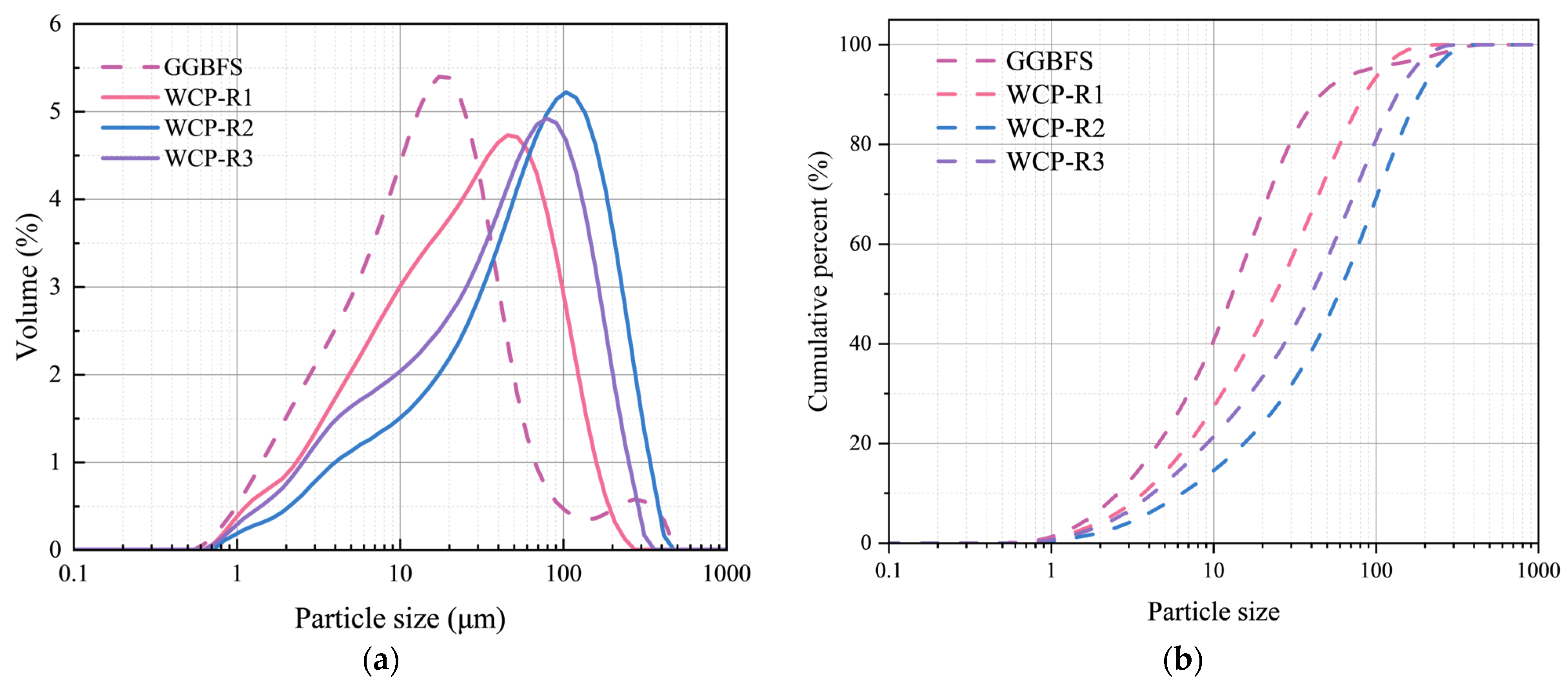

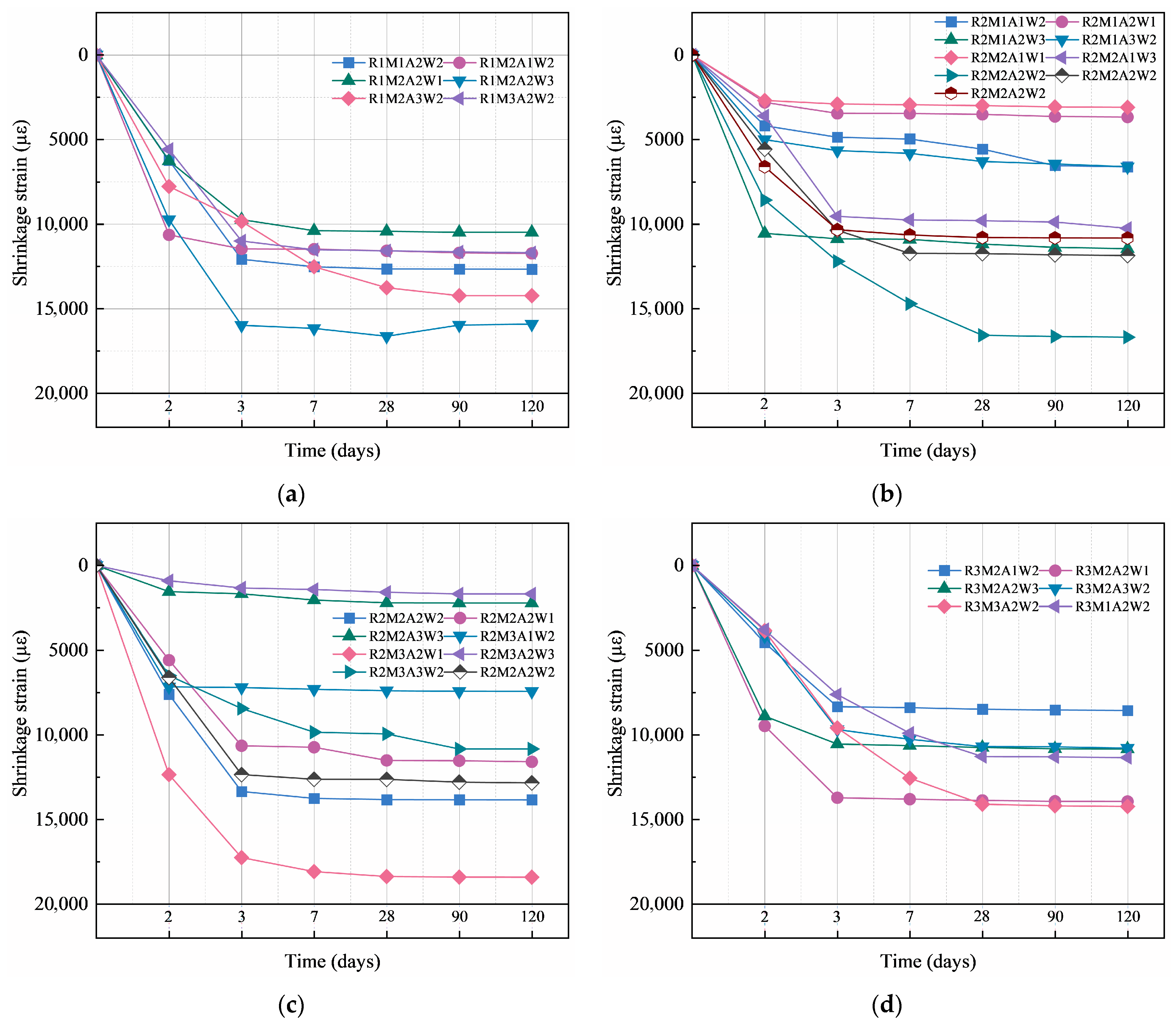
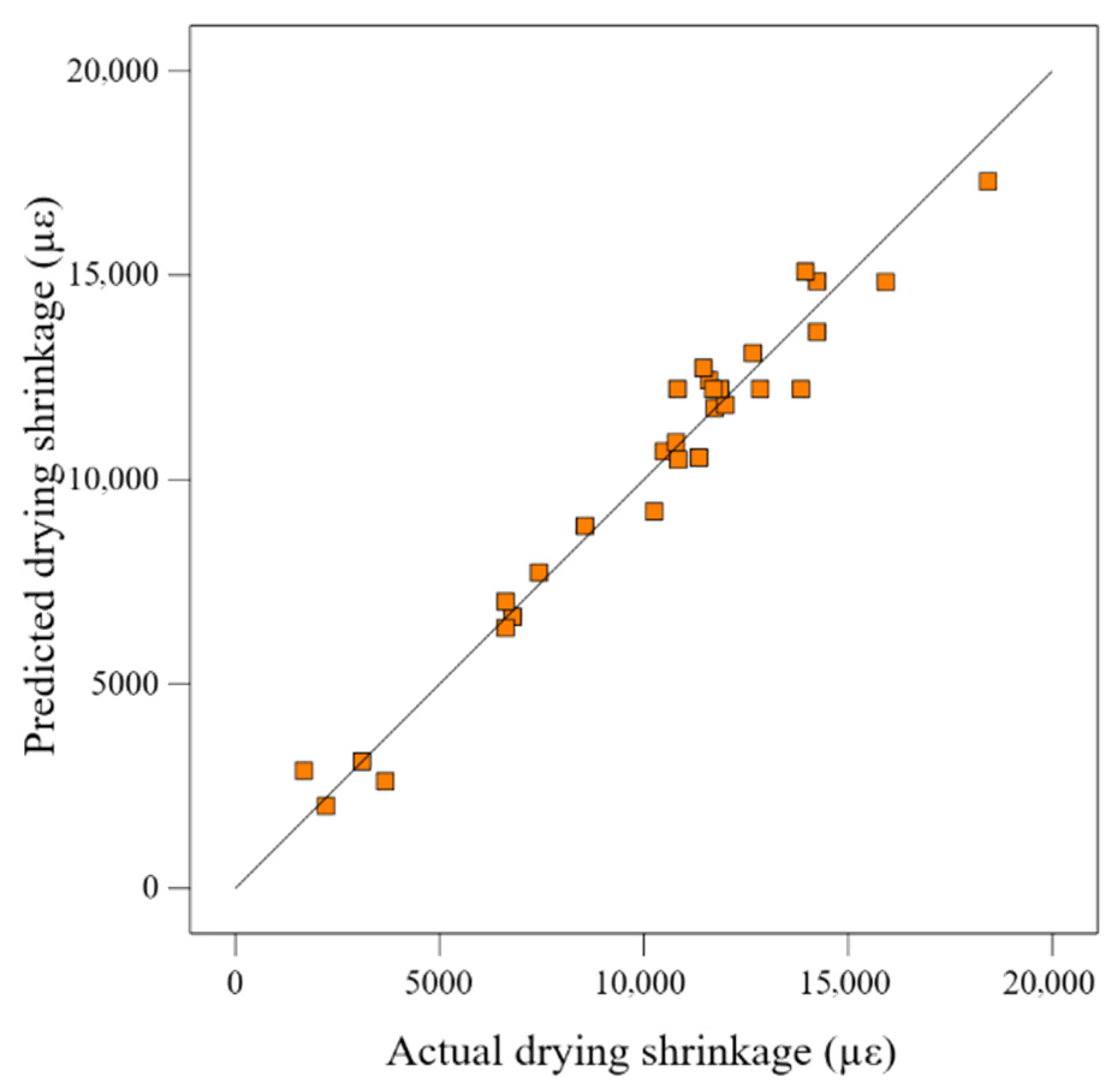

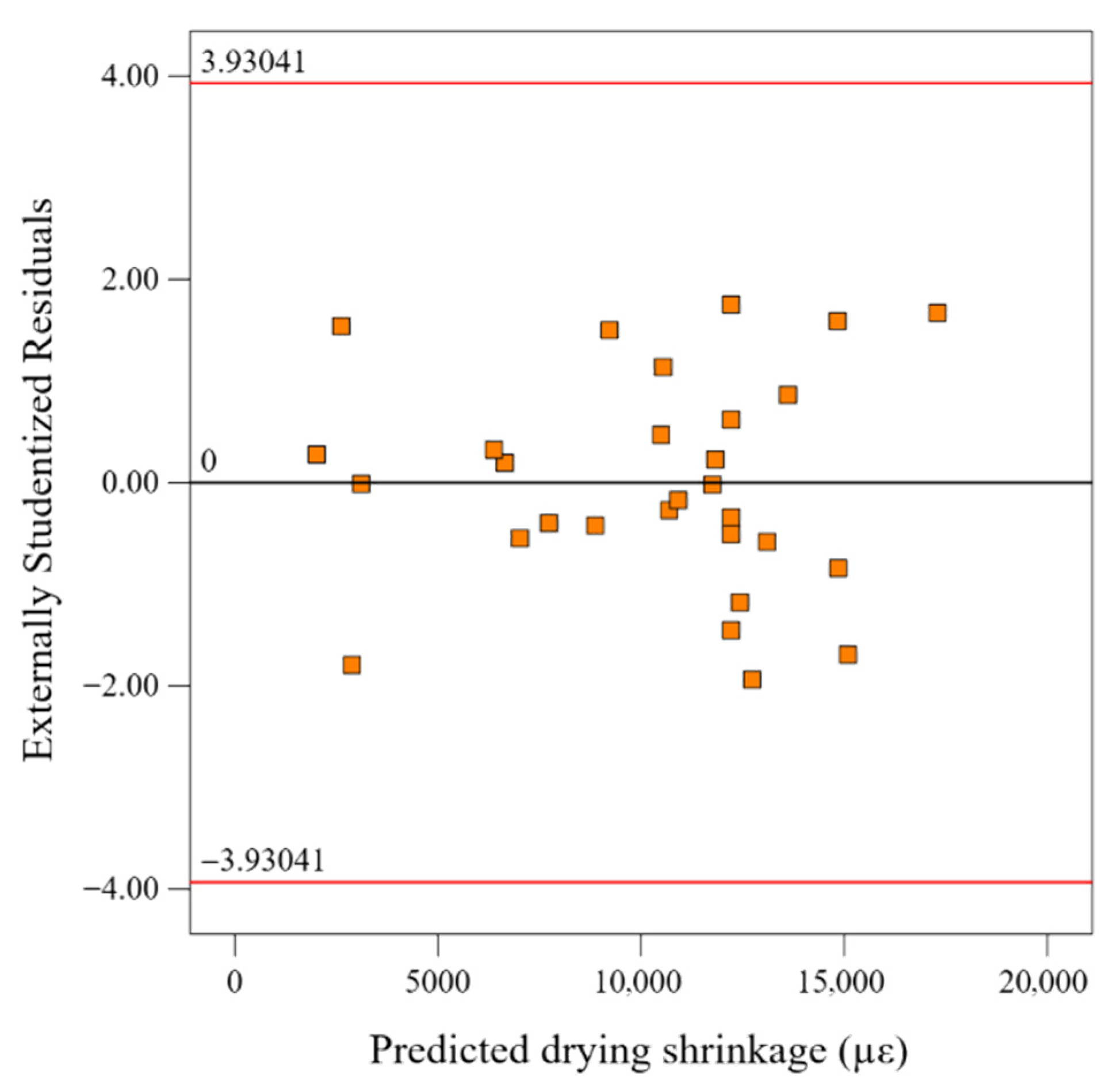
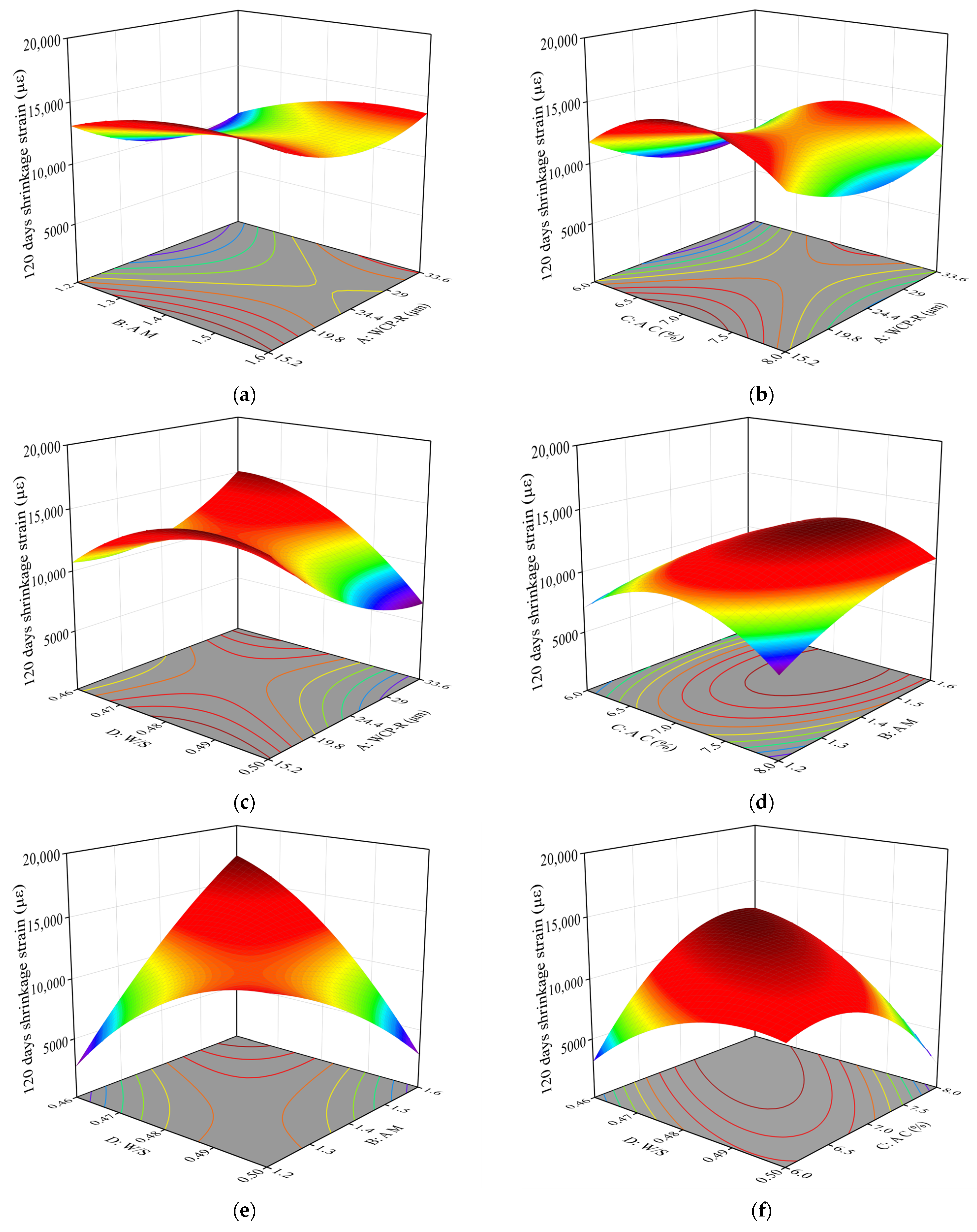

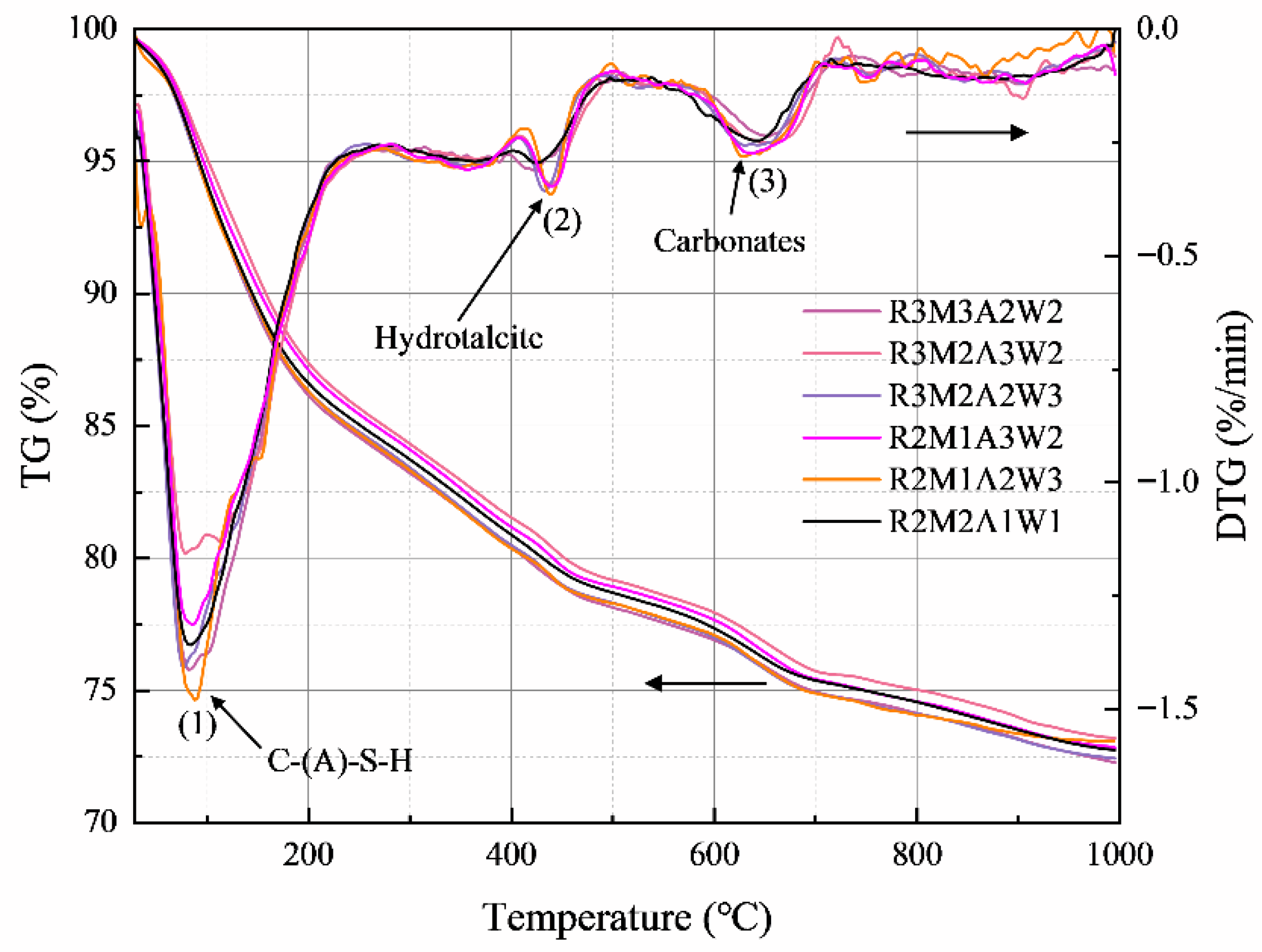



| SiO2 | Al2O3 | CaO | Fe2O3 | SO3 | MgO | K2O | Na2O | TiO2 | MnO | Other | |
|---|---|---|---|---|---|---|---|---|---|---|---|
| WCP | 39.50 | 8.97 | 35.99 | 5.46 | 1.31 | 5.30 | 1.86 | 0.38 | 0.45 | 0.09 | 0.34 |
| GGBFS | 31.5 | 16.73 | 40.72 | 0.3 | 0.25 | 6.44 | 0.38 | 0.07 | 1.35 | 0.47 | 1.79 |
| Variable Factors | Levels | ||
|---|---|---|---|
| 1 | 2 | 3 | |
| WCP-R | 15.2 μm | 24.4 μm | 33.6 μm |
| AM | 1.2 | 1.4 | 1.8 |
| AC | 6% | 7% | 8% |
| W/S | 0.46 | 0.48 | 0.5 |
| Serial Number | Sample Number | WCP-R (μm) | AM | AC (%) | W/S | Shrinkage Strain (µε) |
|---|---|---|---|---|---|---|
| 1 | R2M2A2W2 | 24.4 | 1.4 | 7 | 0.48 | 13,842.3 |
| 2 | R1M2A1W2 | 15.2 | 1.4 | 6 | 0.48 | 11,734.7 |
| 3 | R3M3A2W2 | 33.6 | 1.6 | 7 | 0.48 | 14,239.3 |
| 4 | R3M2A3W2 | 33.6 | 1.4 | 8 | 0.48 | 10,785.1 |
| 5 | R1M2A2W1 | 15.2 | 1.4 | 7 | 0.46 | 10,489.4 |
| 6 | R1M1A2W2 | 15.2 | 1.2 | 7 | 0.48 | 12,669.3 |
| 7 | R2M2A1W3 | 24.4 | 1.4 | 6 | 0.5 | 10,251.4 |
| 8 | R2M3A2W1 | 24.4 | 1.6 | 7 | 0.46 | 18,423.2 |
| 9 | R3M2A1W2 | 33.6 | 1.4 | 6 | 0.48 | 8556.2 |
| 10 | R1M2A2W3 | 15.2 | 1.4 | 7 | 0.5 | 15,918.9 |
| 11 | R1M2A3W2 | 15.2 | 1.4 | 8 | 0.48 | 11,993.7 |
| 12 | R2M2A2W1 | 24.4 | 1.4 | 8 | 0.46 | 11,594.1 |
| 13 | R2M2A2W2 | 24.4 | 1.4 | 7 | 0.48 | 11,696.3 |
| 14 | R2M2A3W3 | 24.4 | 1.4 | 8 | 0.5 | 2220.4 |
| 15 | R2M2A2W2 | 24.4 | 1.4 | 7 | 0.48 | 11,864.2 |
| 16 | R2M1A3W2 | 24.4 | 1.2 | 8 | 0.48 | 6613.6 |
| 17 | R3M1A2W2 | 33.6 | 1.2 | 7 | 0.48 | 11,349.1 |
| 18 | R2M2A2W2 | 24.4 | 1.4 | 7 | 0.48 | 12,845.5 |
| 19 | R2M1A2W1 | 24.4 | 1.2 | 7 | 0.46 | 3671.8 |
| 20 | R3M2A2W1 | 33.6 | 1.4 | 7 | 0.46 | 13,948.1 |
| 21 | R2M2A2W2 | 24.4 | 1.4 | 7 | 0.48 | 10,824.4 |
| 22 | R1M3A2W2 | 15.2 | 1.6 | 7 | 0.48 | 14,239.2 |
| 23 | R2M3A2W3 | 24.4 | 1.6 | 7 | 0.5 | 1682.2 |
| 24 | R2M3A3W2 | 24.4 | 1.6 | 8 | 0.48 | 10,838.9 |
| 25 | R3M2A2W3 | 33.6 | 1.4 | 7 | 0.5 | 6788.4 |
| 26 | R2M1A2W3 | 24.4 | 1.2 | 7 | 0.5 | 11,458.2 |
| 27 | R2M3A1W2 | 24.4 | 1.6 | 6 | 0.48 | 7432.7 |
| 28 | R2M2A1W1 | 24.4 | 1.4 | 6 | 0.46 | 3098 |
| 29 | R2M1A1W2 | 24.4 | 1.2 | 6 | 0.48 | 6615.1 |
| Source | Sum of Squares | Mean Square | F-Value | p-Value |
|---|---|---|---|---|
| Model | 4.496 × 108 | 3.211 × 107 | 25.95 | <0.0001 |
| A | 1.079 × 107 | 1.079 × 107 | 8.72 | 0.0105 |
| B | 1.747 × 107 | 0.1747 | 14.11 | 0.0021 |
| C | 3.368 × 106 | 3.368 × 106 | 7.72 | 0.1212 |
| D | 1.388 × 107 | 1.388 × 107 | 11.21 | 0.0048 |
| AB | 4.358 × 105 | 4.358 × 105 | 0.3522 | 0.5624 |
| AC | 9.700 × 105 | 9.700 × 105 | 0.7838 | 0.3909 |
| AD | 3.962 × 107 | 3.962 × 107 | 32.02 | <0.0001 |
| BC | 2.903 × 106 | 2.903 × 106 | 2.35 | 0.1479 |
| BD | 1.504 × 108 | 1.504 × 108 | 121.53 | <0.0001 |
| CD | 6.829 × 107 | 6.829 × 107 | 55.18 | <0.0001 |
| A2 | 2.275 × 107 | 2.275 × 107 | 18.38 | 0.0008 |
| B2 | 7.315 × 106 | 7.315 × 106 | 5.91 | 0.0291 |
| C2 | 6.848 × 107 | 6.848 × 107 | 55.34 | <0.0001 |
| D2 | 3.351 × 107 | 3.351 × 107 | 27.08 | 0.0001 |
| Lack of Fit | 1.195 × 107 | 1.195 × 106 | 0.8902 | 0.6012 |
| Model | Mean | C.V.% | R2 | Adjusted R2 | Predicted R2 | Adep Precision |
|---|---|---|---|---|---|---|
| 120 day drying shrinkage | 10,264.94 | 10.84 | 0.9629 | 0.9258 | 0.8345 | 19.0962 |
| Serial Number | Total Intrusion Volume (mL/g) | Total Pore Area (m2/g) | Median Pore Diameter (Area) (nm) | Apparent Density (g/mL) | Porosity (%) |
|---|---|---|---|---|---|
| R3M3A2W2 | 0.0381 | 6.269 | 6.92 | 2.1935 | 7.7149 |
| R3M2A3W2 | 0.0401 | 9.466 | 6.55 | 2.1354 | 7.8895 |
| R3M2A2W3 | 0.0482 | 8.157 | 7.06 | 2.1547 | 9.4161 |
| R2M1A3W2 | 0.0435 | 9.892 | 6.62 | 2.1269 | 8.4668 |
| R2M1A2W3 | 0.0497 | 11.873 | 6.76 | 2.1255 | 9.5470 |
| R2M2A1W1 | 0.0383 | 8.173 | 6.59 | 2.1673 | 7.6698 |
Disclaimer/Publisher’s Note: The statements, opinions and data contained in all publications are solely those of the individual author(s) and contributor(s) and not of MDPI and/or the editor(s). MDPI and/or the editor(s) disclaim responsibility for any injury to people or property resulting from any ideas, methods, instructions or products referred to in the content. |
© 2025 by the authors. Licensee MDPI, Basel, Switzerland. This article is an open access article distributed under the terms and conditions of the Creative Commons Attribution (CC BY) license (https://creativecommons.org/licenses/by/4.0/).
Share and Cite
Zou, Z.; Gao, H.; Zhang, Y.; Li, J.; Li, M.; Yu, Y. Multi-Variable Optimization of Sustainable Alkali-Activated Mortar with High Waste Concrete Powder Dosage for Enhanced Drying Shrinkage Resistance. Buildings 2025, 15, 3903. https://doi.org/10.3390/buildings15213903
Zou Z, Gao H, Zhang Y, Li J, Li M, Yu Y. Multi-Variable Optimization of Sustainable Alkali-Activated Mortar with High Waste Concrete Powder Dosage for Enhanced Drying Shrinkage Resistance. Buildings. 2025; 15(21):3903. https://doi.org/10.3390/buildings15213903
Chicago/Turabian StyleZou, Zhen, Han Gao, Yingda Zhang, Jiehong Li, Miao Li, and Yang Yu. 2025. "Multi-Variable Optimization of Sustainable Alkali-Activated Mortar with High Waste Concrete Powder Dosage for Enhanced Drying Shrinkage Resistance" Buildings 15, no. 21: 3903. https://doi.org/10.3390/buildings15213903
APA StyleZou, Z., Gao, H., Zhang, Y., Li, J., Li, M., & Yu, Y. (2025). Multi-Variable Optimization of Sustainable Alkali-Activated Mortar with High Waste Concrete Powder Dosage for Enhanced Drying Shrinkage Resistance. Buildings, 15(21), 3903. https://doi.org/10.3390/buildings15213903







